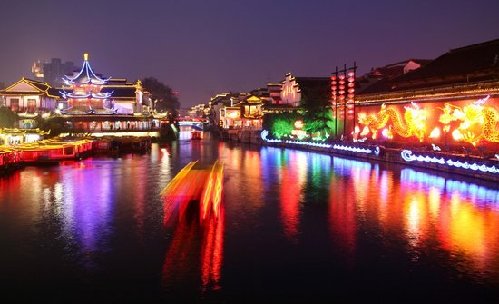Nanjing Confucius Temple (Fuzimiao)
The Confucius Temple in Nanjing was originally constructed in the year of 1034 in the Song Dynasty. It was a place to worship and consecrate Confucius, the great philosopher and educator of ancient China. It is also known as Fuzimiao in Chinese. This temple suffered repeated damage and has been rebuilt on several occasions since that time. 1937 was the most destruction when it was burnt to ruin by Japanese aggressors. In 1984 the temple was rebuilt under the support of the local government. During the long process, the original building expanded to be a complex building in the architectural style of the Ming (1368-1644) and Qing (1644-1911) dynasties, including the Confucius Temple itself, the Jiangnan Gongyuan (the place of imperial examinations) and the Xue Gong (the Imperial Academy). The complex is still called the Confucius Temple out of habit by locals and visitors.

In front of the Confucius Temple, the Qin Huai River is flowing. On the south bank of the river, there is the longest screen wall in China which is 110-meter-long (about 120 yards) and piled with bricks. The Dacheng Hall is recommended on your trip. It is 16.22 meters high (about 53 feet) and 28.1 meters (about 30 yards) wide featuring a 1.5-meter-high (about 5 feet) pedestal. There are two worthwhile attractions found in the inner hall. One is the largest figure of Confucius in China. The other one is the beautiful collection of 38 vivid panels which are made by various jade, gold and silver, detailing the life of Confucius. Out of the hall, you will see the bronze statue of Confucius as well as the white marble statues of his eight disciples.

A fantastic insight into how ancient Chinese governments choose officials can be gained from visiting the Jiangnan Gongyuan. It is a sight not to be missed. The development of Gongyuan began in the Southern Song Dynasty (420-589), expanding into the Ming and Qing Dynasties, until in the reign of Emperor Guangxu in the Qing Dynasty. It developed to be the biggest exanimation school in China. The main building of Gongyuan is the three-storied Mingyuan Tower which is surrounded by 20,644 examination cells, called 'haoshe' in Chinese. Now, a specialized museum on the imperial civil examination system is built here. Visitors also have the opportunity to take simulated exams and experience the joys and sorrows of the candidates.
|

